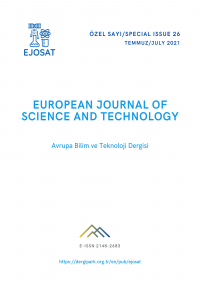Abstract
Bu çalışmada, iki adet 250-Watt redüktörlü DC motor ile üç tekerlekli kişisel elektrikli araç sistemi gerçekleştirilmiştir. Araç, sürücünün yönlendirmesine göre öne, arkaya, sola ve sağa hareket edebilmektedir. Araca hız ve dönüş hareket bilgisi iki farklı potansiyometre ile sağlanmıştır. Catia Bilgisayar Destekli Çizim Yazılımı ile sistemin taşıma kapasitesini anlamak için mekanik analiz gerçekleştirilmiştir. Bu analiz, Z ekseni üzerindeki destek çubuğu olan ve olmayan iki farklı yapı üzerinde farklı iki tip yük (1,5 ve 5kgN) ile gerçekleştirilmiştir. En iyi sonuç, 150 kg yüke kadar taşımak yeterli olacağından Z ekseni destek çubuğu olmadan elde edilmiştir.
References
- International Energy Agency [Internet]. Available from: https://www.iea.org/reports/global-ev-outlook-2020.
- Energy Technology Perspectives 2020 [Internet]. Available from: https://ourworldindata.org/co2-emissions-from-transport.
- Yim H, Lee K. Preliminary modular design for electric personal mobility with design -engineering collaboration. World Electr Veh J. 2015;7(3):426-35.
- Jesús F Lampón, Pablo Cabanelas, Vincent Frigant. The new automobile modular platforms: from the product architecture to the manufacturing network approach. Munich Pers RePEc Arch [Internet]. 2017;(79160). Available from: https://www.researchgate.net/publication/317823991_The_new_automobile_modular_platforms_from_the_product_architecture_to_the_manufacturing_network_approach.
- Henriques FE, Miguel PAC. Use of product and production modularity in the automotive industry: A comparative analysis of vehicles developed with the involvement of Brazilian engineering centers. Gest e Prod. 2017;24(1):161–77.
- Wang H, Candiotti J, Shino M, Chung CS, Grindle GG, Ding D, et al. Development of an advanced mobile base for personal mobility and manipulation appliance generation II robotic wheelchair. J Spinal Cord Med. 2013;36(4):333–46.
- Nakajima S. Improved gait algorithm and mobility performance of RT-mover type personal mobility vehicle. IEEE Access. 2014;2:26–39.
- Nakajima S. Concept of a Personal Mobility Vehicle for daily life. 2016 IEEE Int Conf Robot Biomimetics, ROBIO 2016. 2016;1492–7.
- Ewert A, Brost M, Eisenmann C, Stieler S. Small and light electric vehicles: An analysis of feasible transport impacts and opportunities for improved urban land use. Sustain. 2020;12(19).
- Ling FF. Vehicle Dynamics and Control. Vehicle Dynamics and Control. 2006.
- Jing H, Jia F, Liu Z. Multi-Objective optimal control allocation for an over-Actuated electric vehicle. IEEE Access. 2017;6:4824–33.
Abstract
In this study, three wheels personal electric vehicle system has been conducted with two 250-Watt reduction gear dc motors. The vehicle can move front, back, left, and right sides according to the rider's directions. The directions which speed and turning movement have been provided with 2 different potentiometers to the vehicle. To understand the carrying capacity of the system mechanical analysis has been realized with Catia Computer-Aided Drawing Software. This analysis was conducted with different two types of load (1,5 and 5kgN) on the two different structures that are with Z ax-is support bar and without. The best result was gotten from without a Z-axis support bar because it was sufficient to carry till 150 kg load.
Keywords
Electrics Vehicle Personal Transporter Speed Control Turning Movements Electrics Vehicle, Personal Transporter, Speed Control, Turning Movements
References
- International Energy Agency [Internet]. Available from: https://www.iea.org/reports/global-ev-outlook-2020.
- Energy Technology Perspectives 2020 [Internet]. Available from: https://ourworldindata.org/co2-emissions-from-transport.
- Yim H, Lee K. Preliminary modular design for electric personal mobility with design -engineering collaboration. World Electr Veh J. 2015;7(3):426-35.
- Jesús F Lampón, Pablo Cabanelas, Vincent Frigant. The new automobile modular platforms: from the product architecture to the manufacturing network approach. Munich Pers RePEc Arch [Internet]. 2017;(79160). Available from: https://www.researchgate.net/publication/317823991_The_new_automobile_modular_platforms_from_the_product_architecture_to_the_manufacturing_network_approach.
- Henriques FE, Miguel PAC. Use of product and production modularity in the automotive industry: A comparative analysis of vehicles developed with the involvement of Brazilian engineering centers. Gest e Prod. 2017;24(1):161–77.
- Wang H, Candiotti J, Shino M, Chung CS, Grindle GG, Ding D, et al. Development of an advanced mobile base for personal mobility and manipulation appliance generation II robotic wheelchair. J Spinal Cord Med. 2013;36(4):333–46.
- Nakajima S. Improved gait algorithm and mobility performance of RT-mover type personal mobility vehicle. IEEE Access. 2014;2:26–39.
- Nakajima S. Concept of a Personal Mobility Vehicle for daily life. 2016 IEEE Int Conf Robot Biomimetics, ROBIO 2016. 2016;1492–7.
- Ewert A, Brost M, Eisenmann C, Stieler S. Small and light electric vehicles: An analysis of feasible transport impacts and opportunities for improved urban land use. Sustain. 2020;12(19).
- Ling FF. Vehicle Dynamics and Control. Vehicle Dynamics and Control. 2006.
- Jing H, Jia F, Liu Z. Multi-Objective optimal control allocation for an over-Actuated electric vehicle. IEEE Access. 2017;6:4824–33.
Details
| Primary Language | English |
|---|---|
| Subjects | Engineering |
| Journal Section | Articles |
| Authors | |
| Publication Date | July 31, 2021 |
| Published in Issue | Year 2021 Issue: 26 - Ejosat Special Issue 2021 (HORA) |


